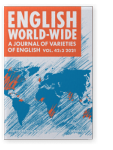Vol. 42:3 (2021) ► pp.273–298
The role of linguistic structure in the perceptions of vernacular speech
Evidence from L1 English and English as a foreign language
This study explores the role of linguistic structure in speakers’ perceptions of vernacular English, i.e. speech used in informal interactions. In so doing, it tests the assumptions of the Interface Principle (Labov 1993) and its major claim that semantic and discourse-pragmatic features will elicit a greater degree of social awareness than morphosyntactic variants (Levon and Buchstaller 2015). Relying on data obtained from 372 respondents, we explore the social perceptions of two discourse-pragmatic and two morphosyntactic variables. We show that the morphosyntactic features investigated here are generally available to the sociolinguistic monitor of L1 speakers as well as highly advanced learners of English as a Foreign Language. However, these morphosyntactic features are less salient than the semantic/discourse pragmatic variants, and their social indexation is, for this reason, more pliable. We argue for the weaker version of the Interface Principle and propose that the differences in the recognisability of vernacular features is gradient. We additionally propose that juxtaposing different types of speaker data is instrumental in discerning those differences.
Article outline
- 1.Introduction
- 2.Salience as a theoretical construct
- 2.1Sociolinguistic salience
- 2.2Psycholinguistic salience
- 3.The linguistic variables
- 4.Data and method
- 5.Results
- 6.Conclusions
- Acknowledgements
- Notes
-
References
